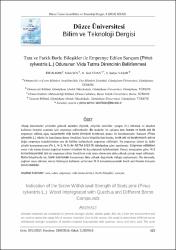Tara ve Farklı Borlu Bileşikler ile Emprenye Edilen Sarıçam (Pinus sylvestris L.) Odununun Vida Tutma Direncinin Belirlenmesi
Access
Attribution 3.0 United Statesinfo:eu-repo/semantics/openAccesshttp://creativecommons.org/licenses/by/3.0/us/Date
2018Access
Attribution 3.0 United Statesinfo:eu-repo/semantics/openAccesshttp://creativecommons.org/licenses/by/3.0/us/Metadata
Show full item recordAbstract
Ahşap malzemeler çevreden gelecek zararları (biyotik, abiyotik zararlılar, yangın vb.) önlemek ve ahşabın kullanım ömrünü uzatmak için emprenye edilmektedir. Bu nedenle; bu çalışma tara, boraks ve borik asit ile emprenye edilmiş ağaç malzemenin vida tutma direncini belirlemek amacı ile hazırlanmıştır. Sarıçam (Pinus sylvestris L.) odunu ile hazırlanan deney örnekleri, borlu bileşiklerden boraks, borik asit ve boraks+borik asit ve doğal emprenye maddelerinden tara ile birlikte kullanılarak emprenye edilmiştir. Bu emprenye işlemi üç farklı çözelti konsantrasyonu (% 1, % 3, % 5) ile ASTM 1413-76 standardına göre yapılmıştır. Emprenye edildikten sonra vida tutma direnci değerleri kontrol örnekleri ile kıyaslanarak belirlenmiştir. Deney sonuçlarına göre; % 5 konsantrasyondaki tara ile emprenye edilen örneklerin vida tutma direncinin daha yüksek çıktığı tespit edilmiştir. Borlu bileşiklerde ise, borik asit+boraks karışımının daha yüksek değerlerde olduğu saptanmıştır. Bu durumda, yağmur suyu etkisine maruz kalmayan kullanım yerlerinde % 5 konsantrasyondaki borik asit+boraks karışımı tercih edilebilir. Wooden materials are conducted to prevent damages (biotic, abiotic pests, fire, etc.) from the environment and are used to extend the usage life of wooden materials. Due to this reason, this study is determined different screw withdrawal strength properties of wooden material impregnated with quechua, borax and boric acid. The scots pine (Pinus sylvestris L.) test specimens are prepared with borax, boric acid, borax + boric acid, from borax compounds which have a great potential in Turkey, and with quechua, one of the natural impregnation substances. Then these samples are impregnated with three different (1%, 3%, 5%) solution concentrations according to ASTM 1413-76 standards. After impregnation, screw withdrawal strength samples are determined compared with control samples. According to the test results; the highest screw withdrawal strength values are determined in solution concentrations with %5 concentration. The highest boron compound values are determined in solution concentrations with boric acid+borax compounds. In this case, the boric acid at a concentration of 1% can be preferred in solid wood applications such as in places which are not exposed to rain water.
Volume
6Issue
2Collections
The following license files are associated with this item:



















